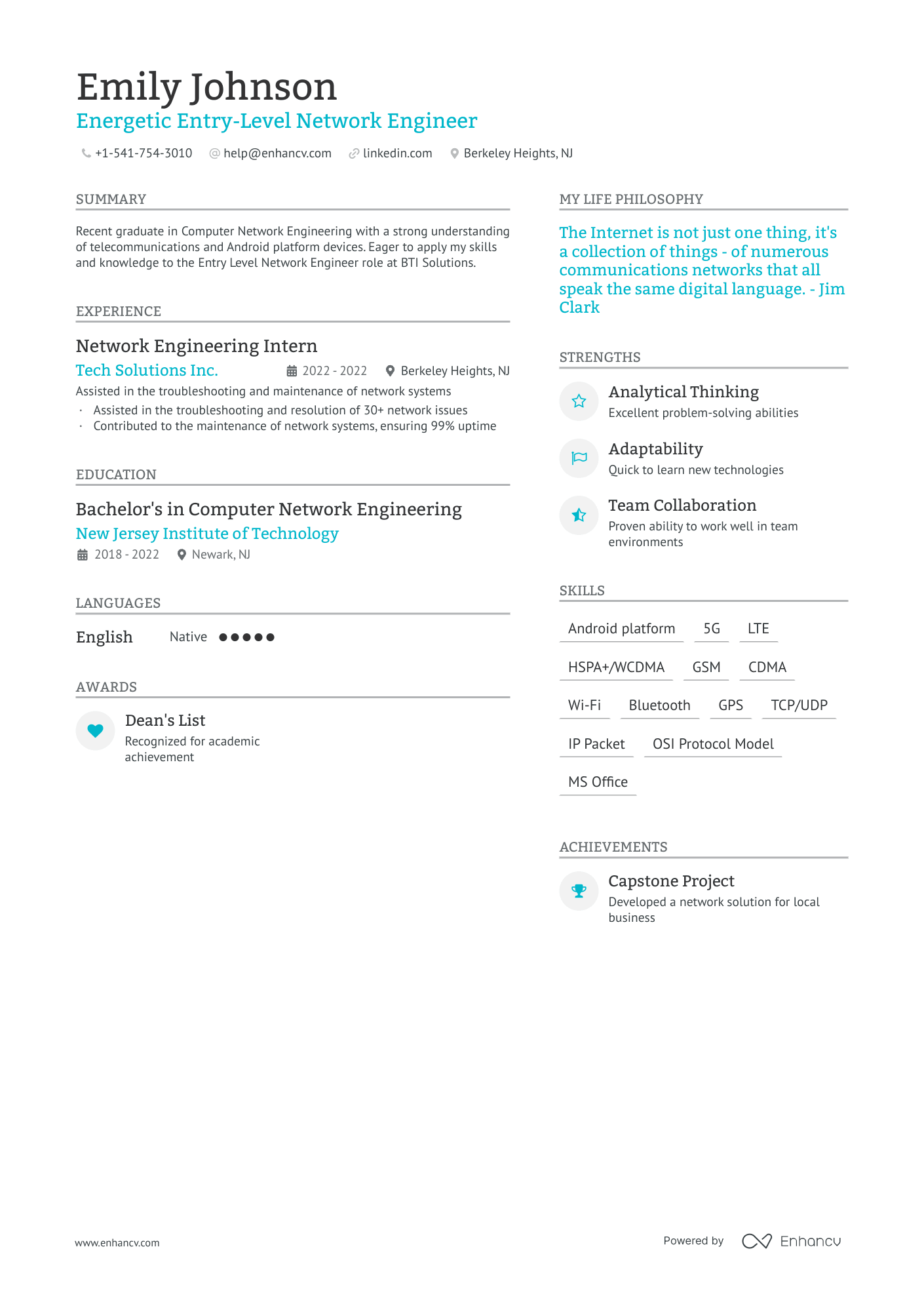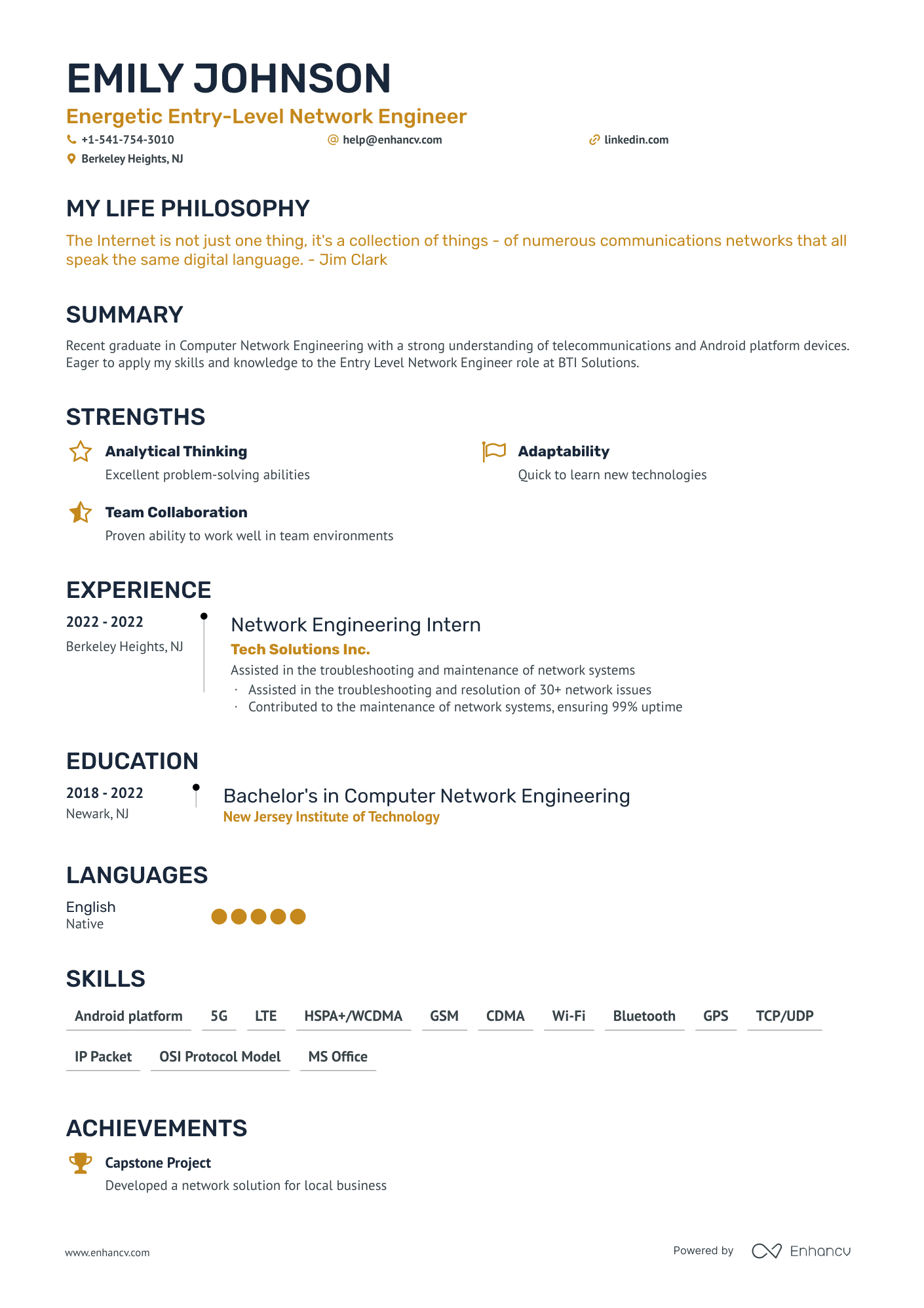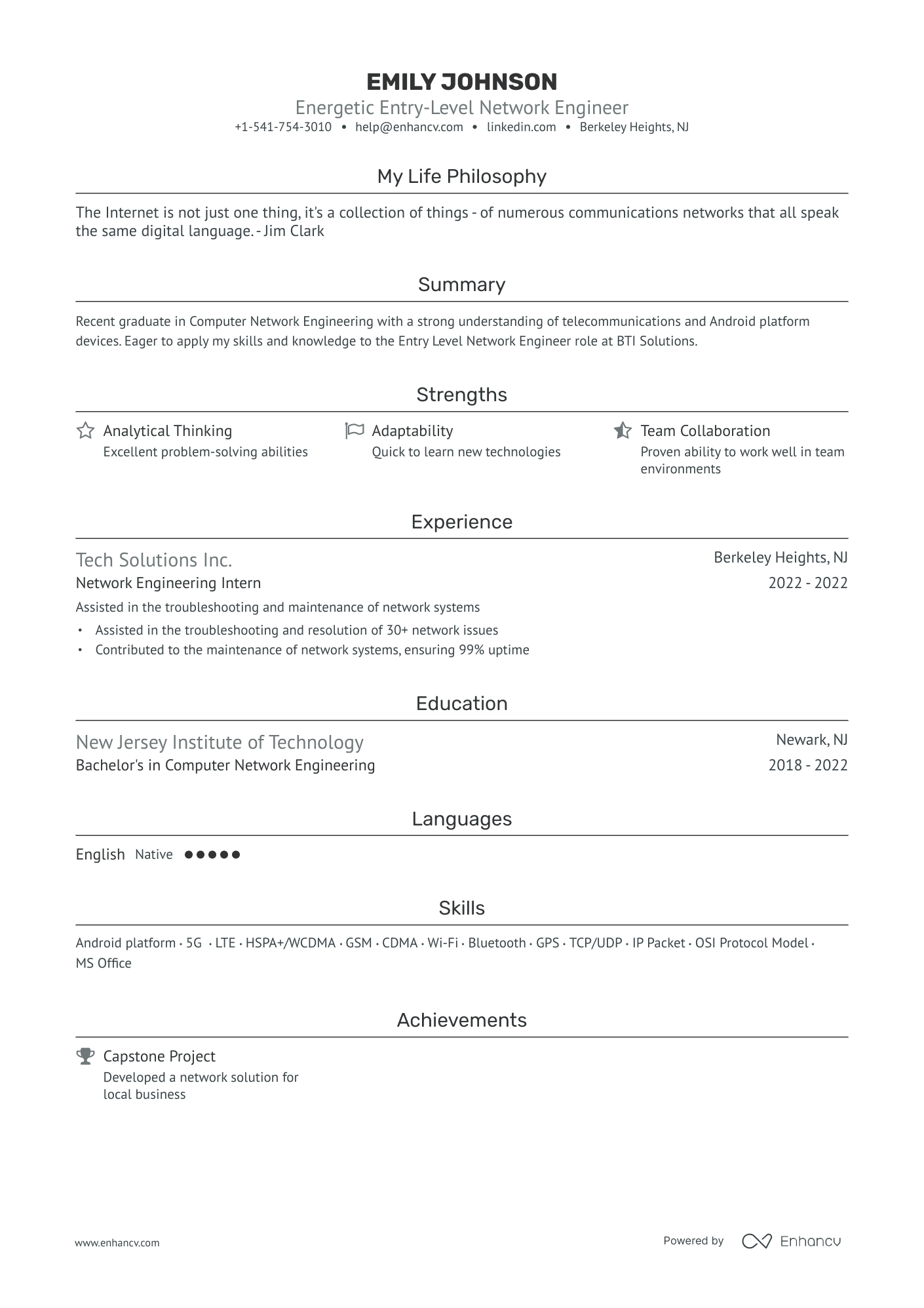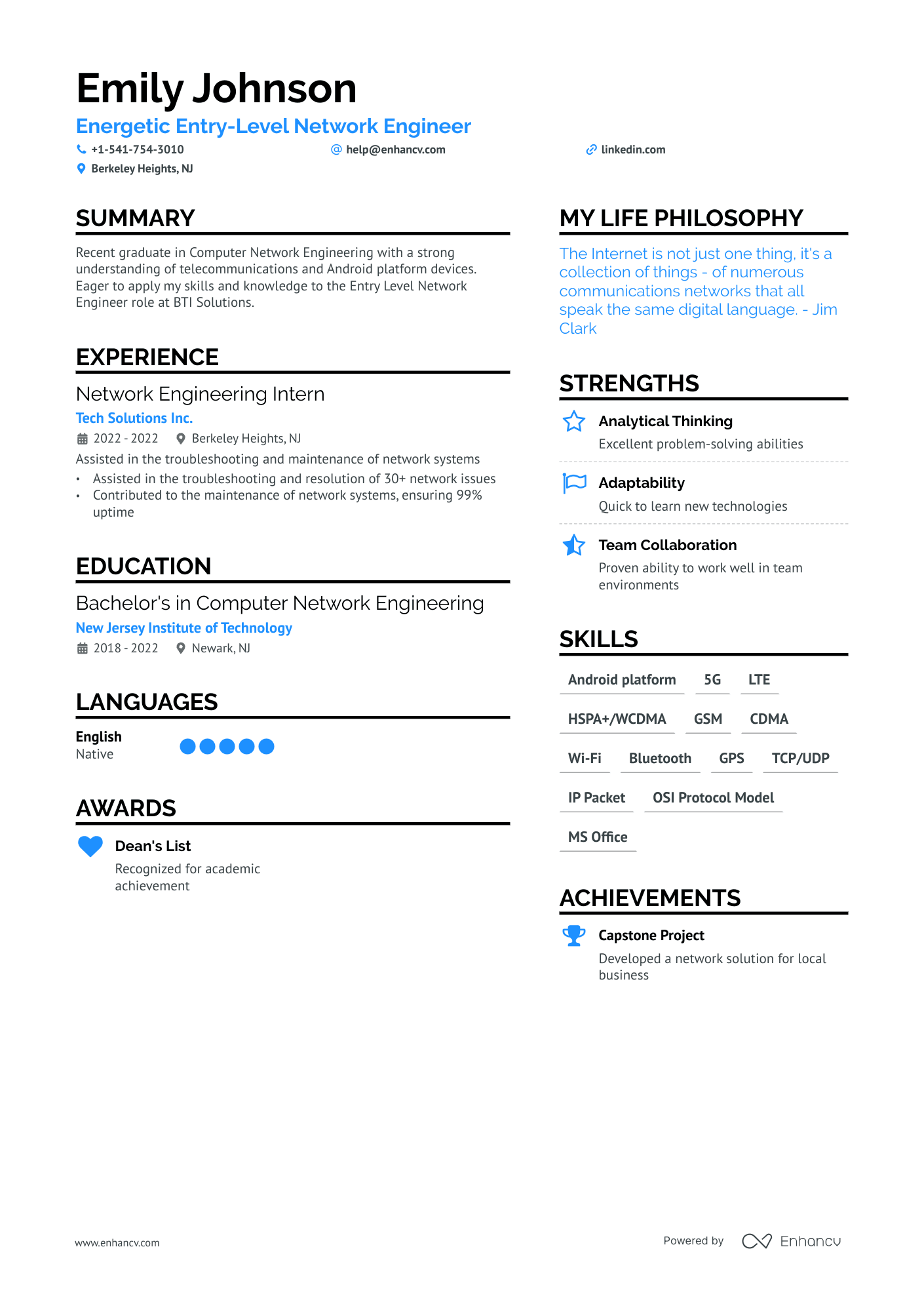Stuck on your entry-level network engineer resume?
We can’t really blame you.
First, HR managers tell you they need a BS in Information Technology or Computer Science.
Second, they want you to show Cisco, Microsoft, HP or Red Hat certs.
Finally, they drop the hammer - 5 years of experience in the IT field recommended.
If our math is right, you need around 12 years to land a Network Engineer job.
So, are there really entry level Networking Engineer jobs out there?
The devil is in the details. Network engineering a career path.
You may not start exactly as a Network Engineer. But you can build your way up there from a Help Desk or NOC position.
Let’s make sure your resume will get you the first job in Network Engineering.
What will you learn from this guide?
- 6 Entry-Level resume examples that showcase candidates’ uniqueness in troubleshooting problems;
- How to make your experience stand out by explaining your value proposition with numbers and results;
- What will be the best resume layout for graduate or entry-level Network Engineering resumes;
- How to build your resume experience with achievements from relevant positions.
- What’s the best way to describe your education degree and certificates on your resume.
Looking for other relevant resumes?
- Freshers Resume Example
- IT Support Resume Example
- Help Desk Resume Example
- Network Engineer Resume Example
- Network Administrator Resume Example
How to write an entry-level network engineer resume
You’ve tried everything.
From requesting help in Employment centers to going on Reddit for career advice.
And you heard all kinds of tips:
- Spend years in entry level IT positions.
- Add every bit of job duties you had so far.
- Follow their specific resume formats.
This probably has left you defeated and still with no job.
In reality, entry-level Network Engineers tend to make common mistakes on resumes.
It’s best to know the ins and outs of that list before you go further.
- Not listing specific achievements from past experience.
- Wordly bullets filled with buzzwords.
- No tailoring to the job role context.
- Not matching major skills with corresponding experience.
Let’s examine all of the above rejection scenarios.
Scenario #1. No concrete achievements on resume
Most applicants tend to fill their experience with job duties.
What they don’t figure out is that responsibilities can be easily inferred from job descriptions.
You can list responsibilities in a short position summary just under the company name.
Save the bullet points below for concrete results that you achieved.
Scenario #2. Flowery language used throughout
Everyone nowadays is a highly-motivated and a diligent team player.
Avoid being generic by dropping overused buzzwords that get resumes thrown away.
Scenario #3. Resume doesn’t provide context for the specific role
It’s not uncommon for Help Desk or NOC employees to apply for entry-level network engineer positions.
What you usually forget is any context and motivation for this transition in your resume.
From listing wrong certificates, to not being specific about the related experience you had, this scenario is a subsequent result of the previous three.
Scenario #4. Skills on resume are mentioned without context
Don’t mention things like TCP/IP, DHCP and DNS, or troubleshooting networks without specifying on your resume how you got this experience.
Your resume sections should be connected together like a well-configured WAN.
Now that we have surfaced the most common mistakes, it’s time to see what makes a resume that lands phone calls 9/10 times.
Top sections on entry-level network engineer resume
- Well-structured resume header.
- Specific projects that you have done.
- A list of relevant certifications
- List your degree with GPA if you have one (GPA higher than 3.2)
- Tailored and memorable resume summary/objective
- Professional experience with achieved results
Anything else you add could make your resume longer than one or two pages, and reduce its impact.
Let’s see what layout will fit them on a single page.
Junior network engineer resume layout
These are the most often met formats in resumes:
- Reverse-chronological layout;
- Functional layout;
- Hybrid resume;
Our preference would go with hybrid resumes, as they combine the best features of reverse-chronological and functional resumes.
Pro tip
You’ve got to have enough work experience to pull off reverse-chronological layout well.
For more information on the best resume formats, read our guide: The Best Resume Formats You Need to Consider (5+ Examples Included).
Entry-level network engineer resume: two sample headers
If you are thinking: “Yet another thing to worry about on my resume”, rest assured. Resume headers are the simplest to fill in.
However, the last thing you want is getting your resume scrapped because of a horrible header.
Give recruiters option to quickly glance on important data, such as:
- Your name
- Phone number
- Email address
- LinkedIn Profile
Many resumes include an address, and it’s okay to put just the city and state you are from.
However, if you are applying for a job outside of your area, you can skip the address. That way the hiring person will know you are open to relocation.
You can also include a (desired) job title below your name. It’s not a bad idea to combine it with a certificate you have for extra bonus points.
Let’s look at two different samples.
Notice how the mention of Cisco certification and the inclusion of LinkedIn profile elevate the second header as opposed to the first one.
If you want more ideas for stand-out resume headers, read through our guide Perfecting Your Resume Header so You Get Noticed.
Let’s keep up the level with the next section.
Entry-level network engineer resume summary examples
You must have heard at least once that recruiters spend no more than 6 seconds on a resume before they move on.
So why bother with summaries?
The answer: they spend 6 seconds before they decide whether to read your resume further.
So, what’s going to keep them occupied?
Resume summaries are the obvious choice, as they are easy to read and always on top.
But a badly written summary can have a negative effect on your application.
This is why we will follow the STAR method to write your summary.
STAR stands for Situation, Task, Action, Result.
In short, it highlights the results of your actions in specific scenarios from the work environment.
Let’s put this into practice.
The first example shows nothing concrete in terms of work experience.
Whereas the second one has a relevant job history, numbers and results and implying people skills without shoving it right in the face.
So, when you write your summary, take into account the following:
- Adding certs and education;
- Years of experience;
- One big achievement to highlight.
For more tips on crafting an attention-grabbing resume summary, check out our guide Resume Summary: How-To Guide (30+ Examples You Need To See). If you’re looking to craft a compelling resume objective instead, read our writing tips at 10 Resume Objective Examples You Need to Steal (How-to-Guide).
Moving on to another important part of your resume.
Optimize your resume summary and objective for ATS
Drop your resume here or choose a file.
PDF & DOCX only. Max 2MB file size.
Entry-level network engineer resume experience section
Demand for Network Engineers usually comes from big corporations.
You need to be able to troubleshoot in a corporate dynamic system and you’ll be faced to find the problem outside of the network.
Here’s what entry-level network engineer resumes should have (according to recruiters):
- Career development
- Going beyond the basics
- Specificity in experience
- Frameworks & protocols you know
Lastly, tie the bullet points above with achievements and results. For the purpose, we will use the STAR method again.
- •Coordinated migration of corporate users from Postfix to Microsoft Exchange Server 2003.
- •Provided Helpdesk and hardware support for IT Issues to retail stores in the US and Canada.
- •Making scripts to minimize errors and speed up delivery.
- •Upgraded Cisco ISR G2 routers.
This bullet points list reads as a job description template.
Even at an entry-level, you should still have stories and achievements worth mentioning.
Let’s see how to weave them throughout.
- •Coordinated migration of 500 corporate users from Postfix to Microsoft Exchange Server 2003.
- •Provided L1 and L2 Helpdesk and hardware support for IT Issues to 500+ retail stores in the US and Canada.
- •Acting as hero and light to other engineers, making scripts to minimize errors and speed up delivery by 70%.
- •Upgraded 30+ Cisco ISR G2 routers.
The ideal entry level Network (or NOC/port jockey) candidate has worked on notable deployments (shown with percentages and numbers).
They have also stacked at least a few months or a year as a help desk.
Make it evident in your resume experience.
For more ideas on how to create an actionable resume experience section, check out our guide How to Describe Your Resume Work Experience.
Time to proceed with the next key element.
How to add your certifications and education
Proper education (or extra curriculum training) is crucial in network engineering.
Be it a Masters degree in Computer Science, or having an impressive catalogue of certs - one could argue how many you actually need.
But to get your foot through the company door - you still have to be relevant to current trends and technologies.
There are three types of certificates in the niche - entry level, professional and expert.
Obviously, you want to start with the first type. Get your CCNA and JNCIA and gradually move on to next-level certificates.
Top 5 certificates in entry-level networking engineering resumes
- Cisco Certified Entry Networking Technician (CCENT)
- Cisco Certified Network Associate (CCNA) – Routing and Switching
- Juniper Networks Certified Specialist Enterprise Switching and Routing (JNCIS ENT)
- Microsoft Certified Solutions Associate (MCSA)
- HP Accredited Integration Specialist (HP AIS)
Just remember, the IT industry will value you on your ability to perform tasks, not on how many papers you got.
One could earn a cert without smelling a piece of equipment.
This is why having hands-on experience as a Network Operations Technician while studying, could help your career take off early on.
Gradually build your way around it - with each certificate comes a sleuth of knowledge you’ll have a chance to practice on the field.
You’ll eventually be able to specialise, be it in advanced Routing and Switching, Network Security, Wireless Routing, VOIP, or even getting a Full-Stack Network Associate certificate.
Browse more essential tips on how to feature education on your resume, in our guide Perfecting the Education Section on Your Resume. For more information on how to properly list resume certifications, we recommend reading our guide How To List Certifications On A Resume (Examples Included).
How to feature a skills section in entry level networking engineer resume
Seeking an entry-level job, your CCNA or CCENT knowledge will pretty much cover most of the hard skills required for the job.
10 hard skills to pull of entry-level network engineer resume
- Network hubs
- Cables & switches
- Firewalls
- Routers
- LAN
- WAN
- IPv4 & IPv6 routing
- Infrastructure technology
- Infrastructure management
- Infrastructure security
Make sure to mention them, as ATS (applicant tracking software) sifts through resumes and checks whether necessary keywords are present.
Run a rain check of your own skills and the job description you’re applying for. Then, make sure there’s a match between what is sought after, and what you provide.
In addition to tech skills, some important soft skills will help you a great deal in the NE field. You’ll most likely be working in a team, report to management or work extra hours to provide connection for regular employees.
So, what will you need?
7 non-technical skills valued by network engineers
- Problem solving
- Communication
- Flexibility
- Multitasking
- Collaboration
- Teamwork
- Critical thinking
Pro tip
To make sure your people skills stand out from the crowd, consider featuring a list of top 3 soft skills in a Talent Section paragraph. In it, you can back them with real examples of your past experience.
Are you still not sure what skills will win recruiters over? Check out our guide on How to Create A Resume Skills Section To Impress Recruiters (+10 Examples You Need to See).
Other sections to include on your resume
Depending on the company, job seniority level and your location, you may want to include more sections to your Entry-Level Network Engineer resume:
- Language skills
- Hobbies and interests
- Projects
- Volunteer work
- Highlights
- References
- LinkedIn on Resume
- GPA
Key elements from writing a job-winning entry-level network engineer resume
- Write impactful summary and experience using the STAR method;
- Make sure you separate some space to mention relevant certificates, if any;
- Describe select few soft skills you own with short example from your previous work;
- Make sure to pick a hybrid layout in order to capture the best from your previous experience and relevant skills;
- Do mention relevant experience as a NOC or Help-Desk support when building your application;




